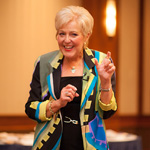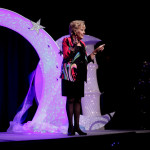Since October contains both National Customer Service Week (Oct. 3-7) and Getting the World to Beat a Path to your Door Week (Oct. 17-23), it seemed especially appropriate to include as a cover article the following discussion of what creates customer loyalty and how employees CAN make a difference in their interactions with customers. Particularly in a library environment dependent upon its customers for survival, understanding of the most current customer loyalty research can make the difference between success or failure.
Barbara Glanz is an internationally known author, speaker, and consultant based in Western Springs, Illinois, and this article is an adaptation of a presentation she gave at the Special Libraries Conference in Atlanta in June. She is the author of The Creative Communicator — 399 Tools to Communicate Commitment without Boring People to Death!, Burr Ridge, Illinois: Irwin Professional Publishing, 1993, and Building Customer Loyalty — How YOU Can Help Keep Customers Returning, Burr Ridge, Illinois: Irwin Professional Publishing, 1994. Her new book C.A.R.E. Packages for the Workplace — 149 Little Things You can Do to Regenerate Spirit at Work will be published by McGraw-Hill in the spring of 1996.She is personally committed to helping individuals understand the important choices they have to make a difference in the workplace.
In many organizations such as yours, customers are “built in.” You have a captive audience in your communities, your schools, or your corporations. Therefore, the idea of building customer loyalty may seem a little strange. Just imagine what would happen to your facility and your jobs, however, if no customers ever used your services! Your customers have many choices as to where to go to get the information they need to do their jobs or enhance their learning. How can you assure that they will come to you, again and again?
Take a moment and think of an organization, store, restaurant, or company to which you feel strongly loyal. In other words, this is a place you choose to go even though you may have other choices. It may be out of your way, and it may even cost a little bit more. However, you choose to go there over and over again. As you think about your relationship with this organization, what comes to mind that might illustrate why you feel loyal to them? What specific things have been done to make you a loyal customer? What do you like about this organization or place? Why do you keep coming back?
We asked this question to several hundred people in a variety of industries across North America. In nearly every case, loyalty was created by the specific actions of one individual employee . The same is true for disloyalty. In his book How to Win Customers and Keep Them for Life, Michael LeBoeuf states the following reasons why customers stop doing business with an organization:
- 1 percent die.
- 3 percent move away.
- 5 percent develop other friendships.
- 9 percent leave for competitive reasons.
- 14 percent are dissatisfied with the product.
- 68 percent leave because of an attitude of indifference toward the customer by the owner, manager, or an employee.
Therefore, the responsibility for creating customer loyalty or disloyalty occurs at the level of every one-on-one interaction with a customer.
A FRAME FOR UNDERSTANDING CUSTOMER LOYALTY
Karl Albrecht in his book At America’s Service says that “every service employee is a manager.” Do all of your employees feel like they are managers? What a difference that could make in their self esteem and feelings of importance! The opportunity for you to make a difference by supplying quality work in a caring way exists at each moment of truth a customer has with you or your organization. Jan Carlzon of Scandinavian Airlines first coined the term “moment of truth.” A moment of truth is “any instance when a customer comes into contact with some aspect of your organization and has an opportunity to form an impression” about the quality of service provided. Every service employee has the CHOICE to manage each of these moments of truth by having control over his or her behavior toward the customer. At each of these moments of truth, many things can go right or wrong to create a strong impression for the customer about the organization. Positive moments of truth are the building blocks of customer loyalty.
One way to better understand how to manage your moments of truth in a way that will impact customer loyalty is to consider that every interaction we have with anyone has two levels — the Business Level which gets the work done or meets the customer’s external objectives and the Human Level which is all about how the customer feels about the interaction. For example, how many of you have been to a doctor who treated you only on the Business Level? How did that feel? Unfortunately, some organizations spend all their time and energy training employees on the Business Level without spending any time helping them create positive moments of truth on the Human Level for their customers.
When we studied customer loyalty, we found that no matter how good your organization is on the Business Level, that will rarely get you above a “C” on the customer report card because your customers expect you to be good at your core business. Rather, it was caring customer service, how the customer is treated in the interactions they have while conducting the business, that impacted customer loyalty and got the organization A’s and B’s on the customer report card. Customer service includes both the people involved as well as the processes that are used (policies, practices, and procedures). How customer-friendly are both your employees and the policies of your library? The answer to this question will greatly impact the number of loyal customers you have.
Since 1973 studies have been done on what customers really want, and the results have been the same every time. Customers say they want four things:
- Friendly, caring service — Customers want to be treated with courtesy and respect. They want to feel that they are important.
- Flexibility — Customers want you to jiggle the system for them and their individual needs. They don’t want to hear “no”; they don’t want to hear all the things you’ve done for others; they want you to creatively figure out a way to get them what they want or need.
- Problem-solving — Customers want the first person they speak to to solve their problem, not the supervisor or manager. The problem may be a business problem such as getting some necessary information for a contract or study or it may be a human problem such as making a decision on colleges for their son or daughter.
- Recovery — When the organization or an employee has made a mistake, the customer wants them to apologize, fix the mistake, do something extra, and follow up. They want it to be taken care of quickly and to their satisfaction. Note that this can become an opportunity to create a loyal customer by recovering quickly and creatively.
You can see that most of the four things customers want fall on the Human, not the Business level. Does your own experience verify this when you think about your answers to the questions posed at the beginning of this article? Therefore, customer loyalty is created by quality core service (the business you are in) that meets the customer’s expectations and caring customer service that exceeds the customer’s expectations.
I have a love / hate relationship with libraries! I am an avid reader, an idolator of books, and I love the peaceful surroundings. However, my personal experiences with libraries have rarely been positive. When I have asked for help, I have either been refused because “they’re too busy,” given such sketchy information that I still couldn’t find what I needed, or made to feel like a complete dummy. All I have needed to become a loyal customer has been a little guidance ( the Business Level) and a dose of TLC (the Human Level)!
HOW CAN YOU CREATE LOYAL CUSTOMERS FOR YOUR LIBRARY?
- You must have quality core service that meets the customer’s expectations. You cannot have loyal customers when products or services fall below what the customers expect. An organization that has poor quality service will probably not stay in business very long! However, even when products or services do meet expectations, core service is not enough to create customer loyalty.
- You must have caring customer service. In every interaction you have with a customer, you have three choices.
- You can choose to discount (-) a customer, making him or her feel less important than you or your organization. That will create a negative experience for the customer, and disloyalty to your organization can result. No one wants to frequent a place where they are made to feel unimportant!
- You may choose to take care of the customer’s business needs (0) only. Just satisfying a customer, however, will only get you a “C” on the customer report card, and with a “C”, the customer is just as apt to leave your organization as to stay. Therefore, just taking care of someone’s business becomes a LOST OPPORTUNITY! You had a chance to create a positive memorable customer experience by meeting his or her needs on the Human Level as well as the Business Level, but you chose not to.
- On the other hand, you may choose to create a positive memorable customer experience (+) by using the four “A’s”: Acknowledge, Appreciate, Affirm and Assure. These are communication skills that occur on the Human Level of the interaction and make a customer feel cared for and special. Each time that you choose to create a positive experience for the customer, you are contributing to creating loyalty to your organization. I use the following quotation by Mother Teresa as my philosophy of life for all interactions: “Be kind and merciful. Let no one ever come to you without coming away better and happier.”
- With creative thinking, you can add enhancers to the customer’s experience. A moment of truth is a memory for the customer, so one of the best ways you can create customer loyalty is to make sure the experience is a positive, memorable one so the customer leaves thinking, “Wow! That was really special!” Enhancers are the little extra things you can do in a typical moment to surprise your customers. For example, a bank teller keeps a pad of Post-It notes in her drawer that say, “I’m glad I saw you today.” While she is transacting the customer’s business, she signs one of the notes and slips it (unknown to the customer) into the customer’s bankbook or other paper from the transaction. Get your creative juices going and think of some enhancers you can add for your customers. Enhancers create memories, and positive memories over time create customer loyalty.
- Here are some other loyalty builders you can apply to your job in the library:
- Trusting the customer.
- Going the extra mile for the customer.
- Recovering in a memorable way when a mistake is made
- Appreciating the customer.
- Taking the initiative to help the customer.
Notice that caring is the most important underlying component of each of these loyalty builders.
Are you a peak performer in your job? Do you have a personal sense of mission that your work is important and that you can make a difference? No matter what your job may be or what is going on around you, you can make a difference by remembering the Human Level and choosing to create a positive experience for each person you encounter.
For each positive choice you make, you are not only helping a customer feel special and creating loyalty for your organization, but you are also making the world better. Caring is exponential — as you make someone’s day better, he or she will feel better about himself, and he or she will, in turn, make someone else’s day better, and the circle goes on. Your sense of mission can become to create loyal customers for your organization as you make positive choices in your interactions, one by one. Caring customer service by each individual employee will cause your customers to “beat a path to your door,” again and again!
© Barbara Glanz Communications. All Rights Reserved.
Barbara Glanz Biography
A member of the prestigious Speaker Hall of Fame and one of fewer than 700 Certified Speaking Professionals worldwide, Barbara Glanz, CSP, CPAE, works with organizations to improve morale, retention and service and with people who want to rediscover the joy in their work and in their lives. She is the first speaker on record to have spoken on all 7 continents and in all 50 states. Known as "the business speaker who speaks to your heart as well as to your head," Barbara is the author of twelve books including The Simple Truths of Service Inspired by Johnny the Bagger®, CARE Packages for the Workplace, and 180 Ways to Spread Contagious Enthusiasm™. Voted "best keynote presenter you have heard or used" by Meetings & Conventions Magazine, Barbara uses her Master’s degree in Adult Learning to design programs that cause behavior change. She lives and breathes her personal motto: “Spreading Contagious Enthusiasm™” and can be reached at bglanz@barbaraglanz.com and www.barbaraglanz.com.




